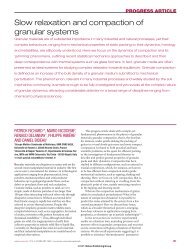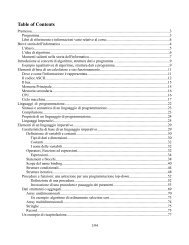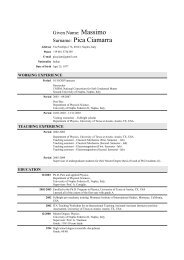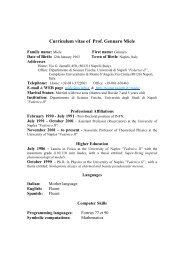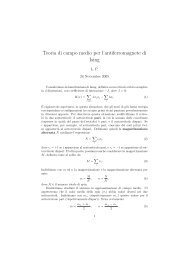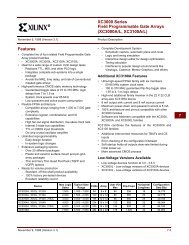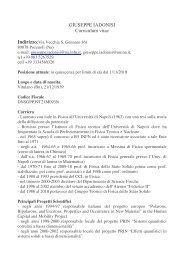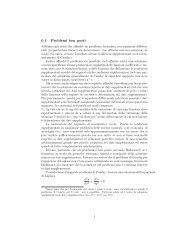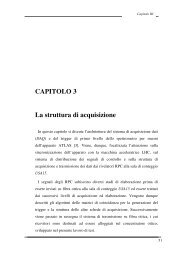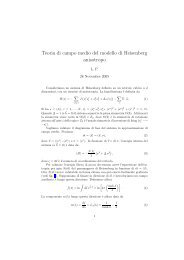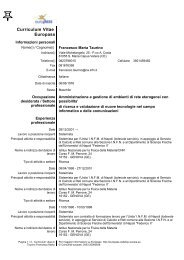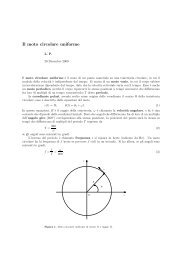Phys Rev E
Phys Rev E
Phys Rev E
Create successful ePaper yourself
Turn your PDF publications into a flip-book with our unique Google optimized e-Paper software.
LIGHT-INDUCED ROTATION OF DYE-DOPED LIQUID¼ PHYSICAL REVIEW E 73, 051707 2006<br />
nar slab of nematic liquid crystal having the same molecular<br />
director as the average one in the droplet. Therefore all diffraction<br />
effects are neglected and the only optical effects left<br />
to be considered are the changes of polarization due to birefringence<br />
and dichroism and eventually the attenuation due<br />
to absorption. Moreover, any distortion of the director configuration<br />
induced by light itself is assumed to be negligible,<br />
due to elastic interactions. As a second approximation, we<br />
treat the input light as a monochromatic plane wave propagating<br />
along the slab normal z. These two approximations<br />
combined are here named “planar symmetry approximation”<br />
PSA. We stress that, despite its common usage 22–24,<br />
PSA is very rough for the typical experimental geometry of<br />
strongly focused light beams and rather small droplets.<br />
Therefore we can only anticipate semiquantitative accuracy<br />
of its predictions. For example, in a strongly focused beam a<br />
large fraction of optical energy is actually associated with<br />
waves propagating obliquely, at a large angle with respect to<br />
z, which will see a much reduced birefringence with respect<br />
to the PSA plane wave. At any rate, all the model inaccuracies<br />
associated with the PSA approximation will not be very<br />
different for pure and dye-doped droplets.<br />
The slab thickness is taken equal to the droplet diameter<br />
d=2R. The liquid crystal birefringence is denoted as n<br />
=ne−n o, where no=Re and ne=Re+a are the<br />
ordinary and extraordinary refractive indices, respectively.<br />
The absorption coefficient is denoted as 0 we neglect the<br />
dichroism for simplicity. The input light beam properties are<br />
the total power P0, angular frequency =2c/, vacuum<br />
wave number k=2/, and a polarization assumed to be<br />
elliptical with its major axis parallel to the x axis and a<br />
degree of ellipticity fixed by the reduced Stokes parameter<br />
s3 or equivalently the ellipsometry angle in a complex<br />
representation of the input plane wave, their definition<br />
*<br />
is s3=sin2=2 ImExEy/Ex2 +E y2. The calculation of the output wave fields emerging at the<br />
end of the slab is lengthy but straightforward, so we skip it.<br />
Inserting the input and output fields in Eq. 15 and integrating<br />
the integration surface V will be given by the two<br />
planes delimiting the slab and corresponding to the input and<br />
output fields; moreover, it is necessary to start the calculation<br />
with a finite wave and then take the plane-wave limit only<br />
after having performed a first integration by parts 25, we<br />
obtain the following final expression of the external electromagnetic<br />
torque 22:<br />
em P0 Mz =<br />
s31−e−20R cos<br />
2 −2 − 1−s3e 0R sinsin 2, 18<br />
where is the angle between the director n and the x axis<br />
within the xy plane and =2kRn is the total birefringence<br />
retardation phase.<br />
It is interesting to note that the two main terms appearing<br />
in Eq. 18 tend to induce conflicting dynamics. The first,<br />
maximized for a circularly polarized input light s3=±1 and<br />
independent of the director orientation, tends to induce a<br />
constant rotation around the z axis, in a direction fixed by the<br />
sign of s3. The second term, instead, maximized for a lin-<br />
051707-5<br />
early polarized input light s3=0 and dependent on the director<br />
orientation, tends to align the average molecular director<br />
of the droplet either parallel or perpendicular to the<br />
x axis, i.e., the major axis of the input polarization ellipse,<br />
depending on the birefringence retardation . For small<br />
values of s3 the latter term dominates and there is always an<br />
em<br />
equilibrium angle at which Mz vanishes. If, instead, the<br />
polarization ellipticity s3 is larger than a certain threshold<br />
s3t=sin2t such that the former term dominates for any<br />
em<br />
value of , the torque Mz cannot vanish and the droplet<br />
must keep rotating although not uniformly, unless s3=±1. The threshold ellipticity is defined by the following equation:<br />
s 3t<br />
e −2 0 R sin<br />
1−s<br />
2<br />
3t<br />
= tan2t =<br />
1−e−20R . 19<br />
cos<br />
It will be useful to consider also the mathematical limit of<br />
Eq. 18 for 0→. This corresponds to the case in which<br />
the torque contribution of the light emerging from the output<br />
plane of the slab vanishes completely, as it occurs for very<br />
large absorption. However, we note that the same mathematical<br />
result is also obtained by taking the average of Eq. 18<br />
over a wide range of birefringence retardations , so that<br />
oscillating terms are canceled out. Such an average may occur<br />
as a result of two factors neglected in our PSA model: i<br />
oblique propagation of strongly focused light in the droplet<br />
in our opinion this is the strongest effect, leading to reduced<br />
n and hence ; and ii propagation of light off<br />
droplet center, leading to an optical path length that is shorter<br />
than 2R. Whatever the actual cause, in this limit the electromagnetic<br />
torque reduces to the simple expression<br />
em em s3P0 Mz = Mz0 = , 20<br />
<br />
corresponding to the total flux of “spin” angular momentum<br />
associated with the input light only.<br />
Let us now turn to the droplet dynamics.<br />
B. Droplet dynamics in the rigid body approximation (RBA)<br />
The RBA approximation can be justified by the fact that<br />
the typical viscosity Leslie’s coefficients of the nematic<br />
liquid crystals a typical value is 1100 cP are much<br />
larger than the water viscosity 1 cP at room temperature.<br />
So any internal shear or relative rotation of the director<br />
with respect to the droplet fluid will be much slower than the<br />
overall droplet rotation with respect to the surrounding water.<br />
Moreover, it is possible that rigid-body behavior of the droplet<br />
in particular in the steady-state dynamical regimes is<br />
further enforced by the elastic interactions in combination<br />
with anchoring conditions this second effect is especially<br />
plausible in the case of imperfect sphericity of the droplets.<br />
Within the RBA, the fluid velocity in the droplet is given<br />
by<br />
vt = t r, 21<br />
where t is the droplet angular velocity. Moreover, the<br />
molecular director is taken to rotate, everywhere in the droplet,<br />
at the same angular velocity as the fluid, i.e., it satisfies<br />
the following equation:



